Beltane Sumi-e Moon
Ted of All Trades came by yesterday. We want to add a screen door on the front so we can keep the front door open during the summer. Screen not for bugs, in this case, but dogs. He offered a couple of suggestions, one we’re considering. Maybe have it open left instead of right. Why? Chinooks and other high winds, often well 0ver 60 mph, can catch, in our situation, a right hand swinging door and wham it against the house.

There’s a gap between our composite deck at the east facing door and the garage. For younger folks, not a big deal, but for Kate, with neuropathy in both feet, the jagged surface created after several snows becomes treacherous. We had a work around the last two years with rubber mats I threw over the snow once I shoveled it, but that’s an imperfect solution. The advantage of the composite decking is that I can use a plastic snow shovel and just shove the snow off. A back preserving snow removal method and one I can then extend all the way to the garage. Ted proposed a floating deck extension. Sounds fine.
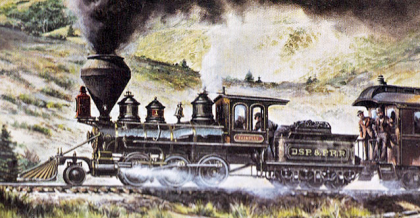 In other trade folk news I had Will out on Tuesday to talk about stump grinding. Two years ago I cut down about 60 trees for fire mitigation. I can do it, but I can’t leave stumps cut very close to the ground, too hard for me to hold the saw steady far below my waist. Lots of centrifugal force on a chainsaw blade and I tip it into the ground. Instant dull blade. With 60 I’m not going to do it. He’s not gotten back to me with a bid because he usually bids stump removal by the inch diameter and I think he’s shocked at the potential cost.
In other trade folk news I had Will out on Tuesday to talk about stump grinding. Two years ago I cut down about 60 trees for fire mitigation. I can do it, but I can’t leave stumps cut very close to the ground, too hard for me to hold the saw steady far below my waist. Lots of centrifugal force on a chainsaw blade and I tip it into the ground. Instant dull blade. With 60 I’m not going to do it. He’s not gotten back to me with a bid because he usually bids stump removal by the inch diameter and I think he’s shocked at the potential cost.
Anyhow he knew a lot of cool stories about our area. Two for instances. Back when Denver was being built, end of the 19th century, there was a mining railroad that ran from Denver all the way to Fairplay, about 60 miles. It ran along the present route of Hwy. 285, our main thoroughfare east and west now. Ore on the train, into the Denver. Smelting.
But. Some smart guy realized that the train also ran through the mountains. Which had lots and lots of old growth Ponderosa and Lodgepole pine. Never been forested. Wait. So much building in Denver, all this wood. Aha. The lumberjacks left the forested east face of the Front Range untouched, a first acknowledgment of a view shed, I suppose, but between there and Fairplay they clear cut everything! Made sense back then. Just trees. Far away from civilization. Free. Today though the small, evenly aged forests that we have, that create much of the fire danger for us are a direct result of this work. Young forests, never thinned, and now with a century + of fire suppression. A combination of the worst possible forest management techniques.

Second story. The Reynolds Gang gold. This was one’s good if you’re a little short on retirement funds. Back in the same time period there was a rip-roaring, bar and brothel filled town called Webster beyond Guanella Pass but before Kenosha Pass. There’s no visible evidence of Webster from 285 today, but then it was a place where miners and lumberjacks came to relax. Or, their equivalent of that idea. Not the sabbath, for sure.
Lots of gold and silver. The Reynolds Gang, twice, robbed Webster, getting away with a substantial horde. A railroad guy asked then governor of Coloradao, John Evans, (a main Denver thoroughfare is named after him), for help. “Sure,” he said. He sent out the Colorado Militia, a group of state paid thugs who had recently mustered out of the civil war. They knew killing.
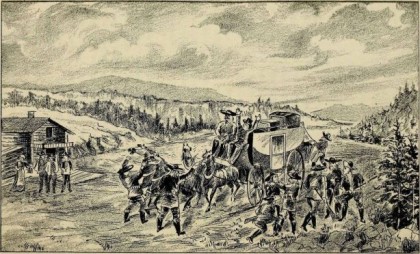 One night they found the gang around a camp fire somewhere still in the Webster area. The Militia, which I think was modeled after the Texas Rangers, did not what any upstanding law enforcers would do. They went in with guns hot, lighting up the night with muzzle flashes. All dead, except a small group, maybe 2 or 3, who escaped with the loot. No one saw them leave and they ran in the dark so they didn’t pay attention to where they ran.
One night they found the gang around a camp fire somewhere still in the Webster area. The Militia, which I think was modeled after the Texas Rangers, did not what any upstanding law enforcers would do. They went in with guns hot, lighting up the night with muzzle flashes. All dead, except a small group, maybe 2 or 3, who escaped with the loot. No one saw them leave and they ran in the dark so they didn’t pay attention to where they ran.
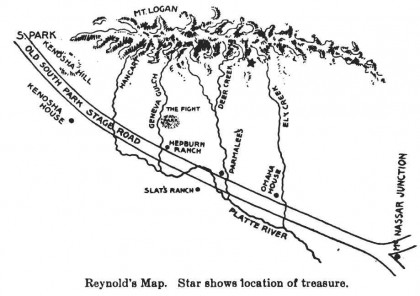 Yes. They dug a hole or found a small cave or animal den, stashed the loot and ran on to escape the militia. They lived long enough to mention to somebody that they’d stuck a knife in a tree to mark the sport. But the militia caught up with them later. Dead. So somewhere in the mountains around the former townsite of Webster is a tree with the tang of a knife protruding, probably about 20 feet up now, allowing for the growth of the tree.
Yes. They dug a hole or found a small cave or animal den, stashed the loot and ran on to escape the militia. They lived long enough to mention to somebody that they’d stuck a knife in a tree to mark the sport. But the militia caught up with them later. Dead. So somewhere in the mountains around the former townsite of Webster is a tree with the tang of a knife protruding, probably about 20 feet up now, allowing for the growth of the tree.
And, no. No one’s ever found it. Get out the metal detector. Or, Kate suggested, power up your drone. We could live large in the third phase on Reynold’s gang gold.

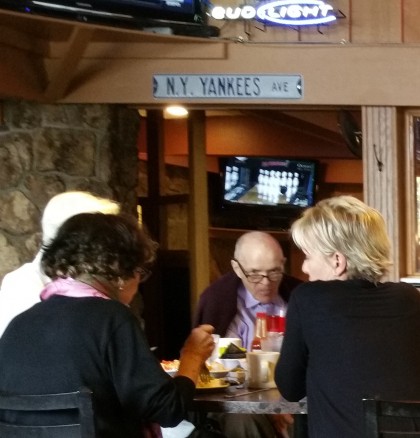
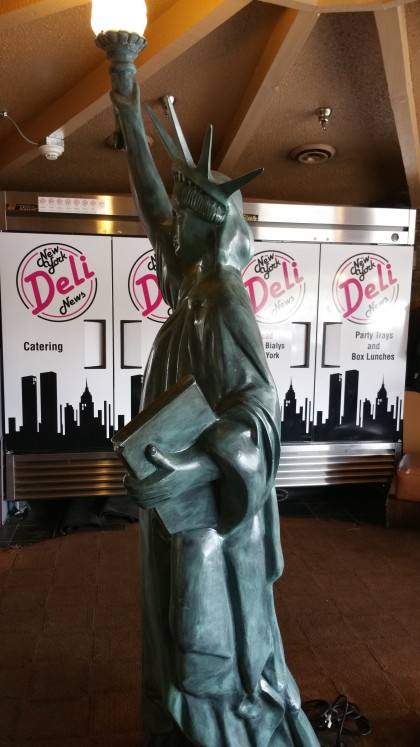
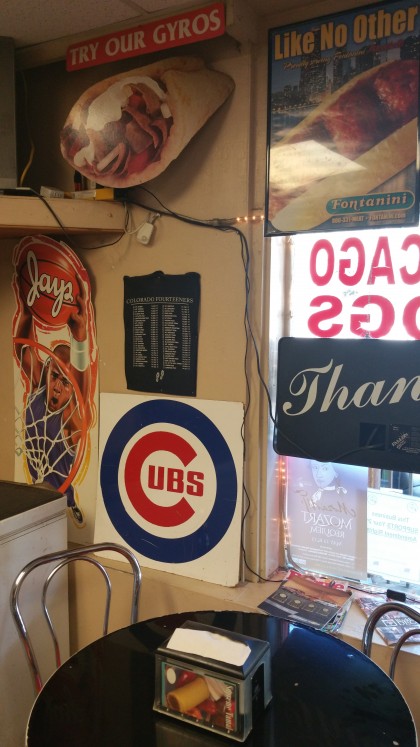

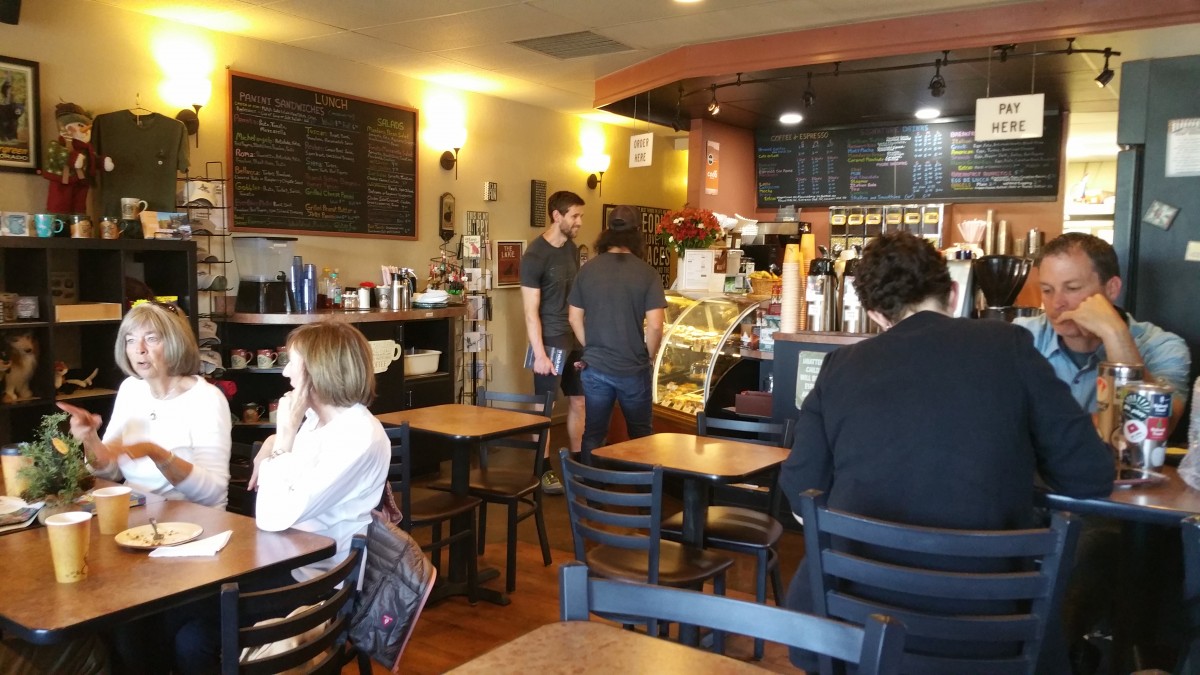
 Earth Day. Thanks, Gaylord Nelson. Gabe’s birthday, too. 10 this year. He got a fidget spinner, an infinity box and a red envelope with money, $10 for each year. This year Earth Day is also Kate’s one month mark after surgery. She’s on an upswing in many ways, weight, pain, nausea.
Earth Day. Thanks, Gaylord Nelson. Gabe’s birthday, too. 10 this year. He got a fidget spinner, an infinity box and a red envelope with money, $10 for each year. This year Earth Day is also Kate’s one month mark after surgery. She’s on an upswing in many ways, weight, pain, nausea.
 In addition to having an Akido studio that is one of the oldest in the country, Domo has a museum of rural Japanese objects, many related to farming or carpentry. They also have art hung in many spots, but in an unobtrusive, organic way. It’s located in an older, warehouse looking building in what is now a rapidly growing part of Denver. A brand new apartment building is under construction right next to it.
In addition to having an Akido studio that is one of the oldest in the country, Domo has a museum of rural Japanese objects, many related to farming or carpentry. They also have art hung in many spots, but in an unobtrusive, organic way. It’s located in an older, warehouse looking building in what is now a rapidly growing part of Denver. A brand new apartment building is under construction right next to it. It’s been an unusual weekend visually with the suspended bee hives and the elk Saturday, the 4/20 celebration at Happy Camper on Friday and Domo yesterday. There is, too, of course, always the mountains. When we drive down the hill into Denver, we leave them behind for a bit, decanting ourselves onto the terminus of the great plains, still high at 5,280 feet, but flat all the same. Last night when we came home, a mountain in the distance toward Evergreen was a flat, pastel teal with pink ribbons of clouds behind it. Only Cezanne could have done it justice.
It’s been an unusual weekend visually with the suspended bee hives and the elk Saturday, the 4/20 celebration at Happy Camper on Friday and Domo yesterday. There is, too, of course, always the mountains. When we drive down the hill into Denver, we leave them behind for a bit, decanting ourselves onto the terminus of the great plains, still high at 5,280 feet, but flat all the same. Last night when we came home, a mountain in the distance toward Evergreen was a flat, pastel teal with pink ribbons of clouds behind it. Only Cezanne could have done it justice.



 Mentioned
Mentioned 



 The last letters of the Hebrew alphabet now have renderings in sumi-e, lying on my table ready for quotes and the chop. A member of Beth Evergreen last night referred to me as an artist. Oh. I thought he said audience. Artist is not a word I’ve ever associated with myself so my brain heard something else. A revealing moment. How others see us is not always, perhaps often, not the way we see ourselves.
The last letters of the Hebrew alphabet now have renderings in sumi-e, lying on my table ready for quotes and the chop. A member of Beth Evergreen last night referred to me as an artist. Oh. I thought he said audience. Artist is not a word I’ve ever associated with myself so my brain heard something else. A revealing moment. How others see us is not always, perhaps often, not the way we see ourselves.

 It was also time to slough off some of the Minnesota based, second phase lingering work. Especially the political. I am going to the caucus this Tuesday; however, I no longer see myself as a dedicated activist. But, and I consider this great news, Ruth told me she was walking out on April 9th, standing outside Mcauliffe, her middle school, for seventeen minutes, one minute for each of the Parkland victims. She’s doing it in spite of the fact that adults tell her no one will listen. Go, Ruth!
It was also time to slough off some of the Minnesota based, second phase lingering work. Especially the political. I am going to the caucus this Tuesday; however, I no longer see myself as a dedicated activist. But, and I consider this great news, Ruth told me she was walking out on April 9th, standing outside Mcauliffe, her middle school, for seventeen minutes, one minute for each of the Parkland victims. She’s doing it in spite of the fact that adults tell her no one will listen. Go, Ruth! The melancholy also uncovered a tension I’d been feeling between leaning in to the domestic, cooking, for example, and Kate and mine’s presence in the Beth Evergreen community, and what I consider my work. Recalibrating second phase expectations about work, which I have not yet fully done, feels like a task for this time. In fact, I enjoy the domestic part of our lives and it feels good to devote more energy to it.
The melancholy also uncovered a tension I’d been feeling between leaning in to the domestic, cooking, for example, and Kate and mine’s presence in the Beth Evergreen community, and what I consider my work. Recalibrating second phase expectations about work, which I have not yet fully done, feels like a task for this time. In fact, I enjoy the domestic part of our lives and it feels good to devote more energy to it.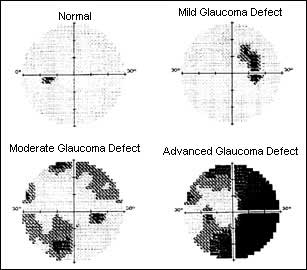 Glaucoma stable. Did a visual field exam yesterday, space invaders with a clicker and dots of light flashing off and on, testing peripheral vision.
Glaucoma stable. Did a visual field exam yesterday, space invaders with a clicker and dots of light flashing off and on, testing peripheral vision. So. More flannels and plaids. Fleece vests. Another pair or two of blue jeans. Some new hat, though I don’t have a particular one in mind right now. There is a tiny part of me that relates to loggers, lumberjacks. Not the whole lumberjack look that spread out from Minnesota a few years back. That’s not still a thing, is it? But related to it. With all the chainsaw work I’ve done over my lifetime I feel I’ve earned some of that.
So. More flannels and plaids. Fleece vests. Another pair or two of blue jeans. Some new hat, though I don’t have a particular one in mind right now. There is a tiny part of me that relates to loggers, lumberjacks. Not the whole lumberjack look that spread out from Minnesota a few years back. That’s not still a thing, is it? But related to it. With all the chainsaw work I’ve done over my lifetime I feel I’ve earned some of that.
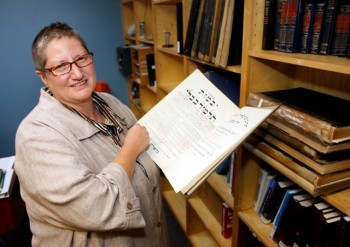 Rabbi Evet teased out characteristics from those stories after a bit and suggested that a way to honor his memory was to figure out how to put back into our little community the attributes lost by his death. His smile. His willingness to help. His commitment to education.
Rabbi Evet teased out characteristics from those stories after a bit and suggested that a way to honor his memory was to figure out how to put back into our little community the attributes lost by his death. His smile. His willingness to help. His commitment to education. I meant that and this experience with Rabbi Evet illustrates it. Beth Evergreen is a place where the heart and the mind both get their due. In fact, lev, the Hebrew word for heart, is also the word for mind. There is no other word for mind. Mind and heart are lev.
I meant that and this experience with Rabbi Evet illustrates it. Beth Evergreen is a place where the heart and the mind both get their due. In fact, lev, the Hebrew word for heart, is also the word for mind. There is no other word for mind. Mind and heart are lev. Life still trickling by. A bit of snow over the last few days, colder now, in the Colorado measure of that term. So relative. Saw a facebook meme with Texans in parkas at 70 degrees. Could have countered that with a Minnesotan in shorts at ten below. Meanwhile 11, last night, felt pretty cold after three years here. These gross physical acclimatizations are easy to spot, but what about the more subtle mental adjustments?
Life still trickling by. A bit of snow over the last few days, colder now, in the Colorado measure of that term. So relative. Saw a facebook meme with Texans in parkas at 70 degrees. Could have countered that with a Minnesotan in shorts at ten below. Meanwhile 11, last night, felt pretty cold after three years here. These gross physical acclimatizations are easy to spot, but what about the more subtle mental adjustments? This is all by way of becoming native to this place, a key element in my pagan creed borrowed from Wes Jackson at the
This is all by way of becoming native to this place, a key element in my pagan creed borrowed from Wes Jackson at the  Kate and I did it on the Great Anoka Sand Plain. Over the Andover years we listened to the soil, to the rhythms of the growing season. We stuck our hands in the soil, partnered with it. We planted trees and fruit bearing shrubs. There was the open prairie we cultivated on either sides of the more traditional suburban lawn carpet. Bees, with whom we partnered, for honey. Dogs who used the woods as their home and hunting ground. By the time we left we were native to that place. Its rhythms shaped our own and together we created a place to live.
Kate and I did it on the Great Anoka Sand Plain. Over the Andover years we listened to the soil, to the rhythms of the growing season. We stuck our hands in the soil, partnered with it. We planted trees and fruit bearing shrubs. There was the open prairie we cultivated on either sides of the more traditional suburban lawn carpet. Bees, with whom we partnered, for honey. Dogs who used the woods as their home and hunting ground. By the time we left we were native to that place. Its rhythms shaped our own and together we created a place to live.